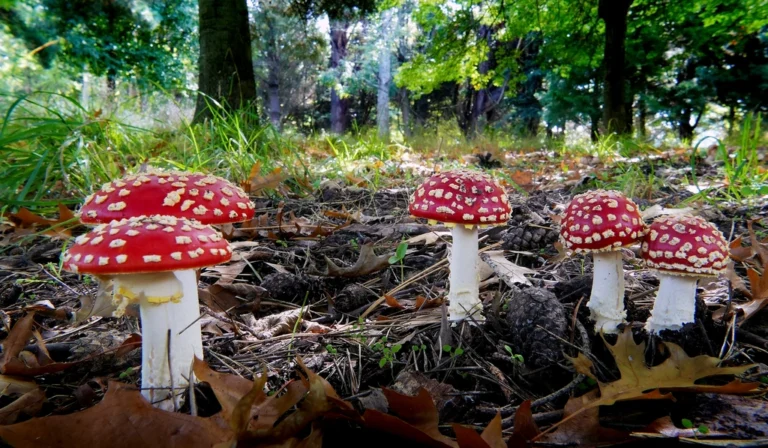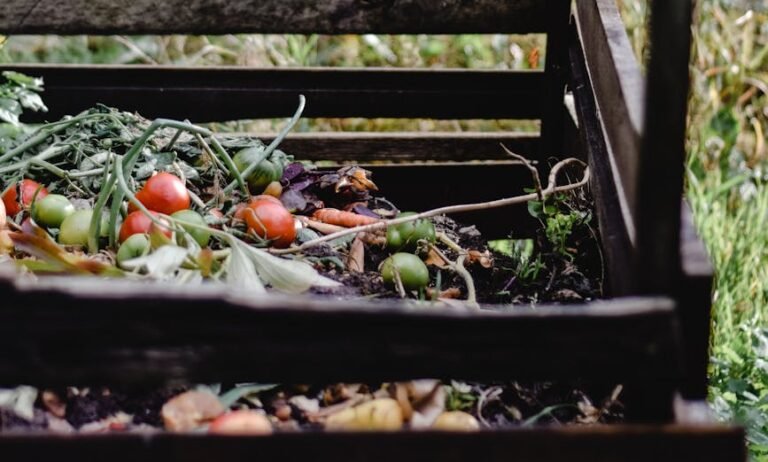Introduction to Composting and Mulching with Fall Leaves
As the vibrant colors of autumn unfold, gardeners and landscapers are presented with a unique opportunity to leverage the seasonal bounty of fallen leaves. Composting and mulching with these natural materials offer numerous benefits for soil health, making them an essential component of sustainable gardening practices. The process of composting involves breaking down organic matter, such as leaves, into nutrient-rich humus that can significantly enhance soil structure and fertility. Similarly, mulching with leaves helps to retain moisture in the soil, suppress weeds, and provide a habitat for beneficial organisms.
Collecting leaves during the fall not only aids in waste management by recycling natural debris but also provides an abundant resource that is readily available to gardeners. These leaves act as a carbon source in composting systems, balancing nitrogen-rich materials like grass clippings and kitchen scraps. This balance is crucial for creating a successful compost pile that accelerates the decomposition process, ultimately resulting in rich compost that supports plant growth.
In addition to their composting benefits, leaves can be effectively utilized as mulch. When spread in garden beds, leaf mulch protects roots from temperature fluctuations, minimizes soil erosion, and enhances the aesthetic value of the landscape. Leaves decompose over time, slowly releasing nutrients back into the soil, creating a continuous cycle of enrichment. However, it is essential to utilize the right types of leaves, as some may contain compounds that could hinder plant growth. Understanding which leaves to include and which to avoid is vital for optimizing the benefits of this practice.
In summary, utilizing fallen leaves for composting and mulching not only promotes earth friendly gardening practices but also enriches the soil, ultimately fostering healthier and more productive gardens. Embracing this seasonal resource empowers gardeners to contribute positively to both local ecosystems and the wellbeing of their plants.

Nutritional Benefits of Fall Leaves in Compost
Fall leaves play a vital role in enhancing compost quality due to their rich nutritional content. They are primarily composed of carbon, which is an essential element for the composting process. Often referred to as “brown” materials, dried leaves contribute significantly to the carbon-to-nitrogen ratio in compost piles. A balanced ratio of carbon and nitrogen is crucial for the microbial activity that drives the decomposition process, ultimately resulting in nutrient-rich compost.
In addition to carbon, many types of fall leaves also contain varying levels of nitrogen. While leaves are generally lower in nitrogen than other compost materials, such as grass clippings or kitchen scraps, they still contribute to the overall nutrient profile of the compost. Moreover, the presence of trace minerals found in leaves, such as potassium, phosphorus, and magnesium, enhances the nutrient content of compost, making it invaluable for enriching garden soil.
As the leaves break down, they support a diverse community of microbes that are essential for effective composting. These microorganisms help in the breakdown of organic matter, increasing the compost’s temperature and accelerating the decomposition process. The compounds released during decomposition, such as humic acids, help improve soil structure and fertility. This enriched compost can boost plant health and resilience, making it an indispensable resource for gardeners and landscapers alike.
However, not all leaves provide the same benefits. Some types, like oak leaves, can take longer to decompose due to their higher lignin content. Therefore, mixing various types of leaves, along with other compost materials, can lead to a more balanced and effective composting process. In conclusion, fall leaves serve as an essential component in composting, not only contributing vital nutrients but also enhancing microbial activity necessary for producing rich, high-quality compost.

How to Properly Collect and Prepare Fall Leaves
Collecting fall leaves for composting and mulching is a rewarding endeavor that can enhance your garden’s health and aesthetics. The first step is to determine the optimal time for collection. Generally, the best time to gather leaves is in the late fall, after most of the leaves have fallen but before winter weather sets in. This timing ensures that you gather a significant volume of leaves while they are still fresh and dry, which makes them easier to handle and process.
When considering the types of leaves to collect, it is essential to understand that not all leaves are created equal for composting. Ideally, you should favor leaves from hardwood trees such as oaks, maples, and sycamores. These leaves decompose efficiently and provide essential nutrients to your soil. On the other hand, avoid leaves from black walnut trees, as they contain juglone, a compound that can be toxic to many plants. Additionally, be cautious with pine needles; while not harmful, they can create acidic conditions in your compost.
Once you have gathered your leaves, the preparation process is key for optimal breakdown. Chopping or shredding leaves into smaller pieces can significantly speed up their decomposition. This can be achieved through a lawn mower, leaf shredder, or even by hand using garden shears. If shredding isn’t feasible, simply layering the leaves in your compost pile is an effective alternative. This layering technique helps to maintain adequate airflow, which is crucial for microbial activity and faster decomposition.
In conclusion, taking the time to properly collect and prepare fall leaves will not only enhance your composting and mulching practices but also boost the overall health and vitality of your garden soil.

Using Leaves as Mulch: Benefits and Techniques
The practice of using fall leaves as mulch offers a multitude of benefits for gardeners looking to enhance soil health and promote plant growth. One of the primary advantages is moisture retention; leaf mulch acts as a barrier, reducing evaporation from the soil. This quality is particularly beneficial during dry periods, as it helps maintain adequate hydration for plant roots. Additionally, the layer of leaves moderates soil temperature, protecting your plants from extreme heat in the summer and frost in the winter.
Weed suppression is another significant benefit of incorporating leaf mulch into garden beds. A well-applied layer of leaves can effectively block sunlight from reaching weed seeds, thereby preventing their germination and growth. This not only saves time and effort in weed management but also helps ascertain that the nutrients in the soil are primarily utilized by the desired plants.
When implementing leaf mulch in gardens or flower beds, it is crucial to consider the application techniques. Shredded leaves decompose more quickly and create a finer texture that is easier to manage. Aim for an application depth of about 2 to 6 inches, ensuring that the mulch is thick enough to provide benefits without smothering emerging plants. It is also advisable to keep the mulch a few inches away from the stems of plants to prevent rot and pests.
Regularly monitor the mulch layer and add more as it decomposes to maintain its effectiveness. By utilizing fall leaves as mulch, gardeners can create a sustainable solution to improve plant health while reducing gardening workload and promoting a thriving ecosystem in their outdoor spaces.

Carbon to Nitrogen Ratio: Achieving Balance in Composting
The carbon to nitrogen (C:N) ratio is a crucial aspect of successful composting, particularly when using fall leaves as a primary ingredient. Leaves typically possess a high carbon content, which is beneficial for composting; however, an excessive amount of carbon can lead to a slower decomposition process. Therefore, it’s essential to balance the high carbon input from leaves with nitrogen-rich materials. This balance enhances microbial activity, ultimately resulting in a more effective composting process.
Nitrogen acts as a catalyst for decomposition by supporting the growth of microorganisms that break down organic matter. When assessing materials to introduce into the compost, it is crucial to identify those high in nitrogen. Examples include kitchen scraps, grass clippings, manure, and leguminous plants. By incorporating a variety of nitrogen sources, gardeners can achieve an optimal C:N ratio, ideally ranging between 25:1 to 30:1. With this balance, compost becomes nutrient-rich and beneficial for garden soil.
While fall leaves present an abundant source of carbon, it is generally recommended to mix them with nitrogen-rich materials. For instance, mixing one part nitrogen source with three parts leaves can help in achieving the desired balance. However, it is vital not to overdo nitrogen additions, as too much can lead to an unpleasant odor and hinder the composting process. Furthermore, the different decomposition rates of various materials must be taken into account, as some might break down more slowly than others.
In summary, maintaining the right carbon to nitrogen ratio is essential when composting with fall leaves. By integrating nitrogen-rich materials appropriately, gardeners can facilitate a more efficient breakdown of organic matter, resulting in high-quality compost that ultimately enriches the garden ecosystem.

Common Allelopathic Leaves to Avoid in Your Compost
When it comes to composting and mulching, it is essential to be aware of the types of leaves you incorporate into your organic matter. Some leaves contain allelopathic properties that can inhibit seed germination and plant growth due to the presence of specific chemical compounds. Understanding which leaves to avoid will improve the efficacy of your compost and enhance the health of your garden.
A prominent example of an allelopathic leaf is that of the black walnut tree (Juglans nigra). This tree releases a compound known as juglone, which can be toxic to many plant species. The roots, leaves, and even the husks of black walnuts can adversely affect compatible plant growth in nearby areas. Consequently, incorporating black walnut leaves into your compost could hinder its overall effectiveness, leading to unfavorable gardening conditions.
Another significant example is eucalyptus leaves. Eucalyptus trees exude a variety of chemicals that can deter plant growth, which is largely due to their high oil content and leachable compounds. These leaves can create an unfavorable environment in the compost pile or mulching layer, significantly impacting the growth of other plants by inhibiting the development of seedlings. Therefore, it is prudent to steer clear from adding eucalyptus leaves in your compost heap.
In addition to black walnut and eucalyptus, several other species, such as certain members of the pine family and some perennial herbs, can also display allelopathic tendencies. The best practice is to familiarize yourself with these plants and their respective leaves, ensuring that you utilize only the most beneficial organic matter in your composting. By avoiding these allelopathic leaves, you will promote a healthier, more productive gardening environment.

Signs of a Healthy Compost with Leaves
Monitoring the health of your compost pile is crucial to ensuring that it effectively decomposes organic matter, including fall leaves. One of the primary indicators of a healthy compost system is its temperature. An active compost pile should reach a temperature between 130°F and 160°F. This heat indicates that microbial activity is thriving, breaking down the leaves and other materials. If you find that your compost is not heating up adequately, it may require more nitrogen-rich materials to stimulate microbial growth.
Another significant aspect to observe is moisture. A healthy compost pile should feel damp, similar to a wrung-out sponge. If it is too dry, decomposition will slow down, while excessive moisture can lead to anaerobic conditions. To maintain optimal moisture levels, periodically check your compost and add water or dry materials, depending on the current state.
The earthy smell is also an excellent gauge of compost health. A well-functioning compost pile emits a pleasant, earthy aroma, indicating the presence of beneficial microorganisms. If you notice strong, unpleasant odors, this may be a sign of anaerobic decomposition, often caused by an excess of wet materials or insufficient aeration. Turning the pile regularly can help introduce oxygen and alleviate this issue.
The rate of decomposition is yet another visual cue. Healthy compost should break down the leaves and other organic materials within several weeks to months, depending on the type of materials and environmental conditions. If the leaves remain intact for an extended period, this may suggest that they are too dry or not mixed adequately with other compost ingredients. Regularly turning your compost and maintaining a balanced mix can enhance the decomposition process. By paying attention to these signs, you can create a thriving compost ecosystem that effectively utilizes fall leaves and other organic materials.

Creative Ways to Incorporate Fall Leaves in the Garden
The colorful fall leaves that blanket gardens each autumn are not just a seasonal visual delight; they hold numerous potential uses that enhance both beauty and biodiversity in your garden. One creative method to utilize these leaves is through leaf art, which can transform your outdoor spaces into living canvases. Gardeners can create designs by layering various colors and sizes of leaves, forming intricate patterns on flower beds or pathways. Leaf art can also be extended to creating decorative wreaths or wall hangings, showcasing the vibrant hues of fall foliage and celebrating the season in a unique manner.
Another innovative approach to using fall leaves is the production of leaf mold. This organic material is created by decomposing leaves over time in a designated area, resulting in a rich, loose soil amendment that enhances garden soil structure and moisture retention. To create leaf mold, gather fallen leaves and pile them in a corner of your garden or in a bin. Though the process can take a year or longer, the resulting leaf mold will provide excellent benefits for soil health and plant growth, making it a valuable addition to any gardening strategy.
Additionally, fallen leaves serve as a natural habitat for beneficial organisms. By intentionally leaving some leaves in your garden beds, you create a protective layer that fosters an environment for insects, worms, and microorganisms. This biodiversity-friendly approach helps in promoting pollination and pest control, as these organisms contribute to the overall ecosystem balance. Employing these methods not only maximizes the potential of fall leaves but also promotes sustainable gardening practices. They encourage creativity, soil enrichment, and support for local wildlife, reinforcing the multifaceted benefits of collecting and using fall leaves in your gardening endeavors.

Conclusion: Embrace Fall Leaves in Your Garden
Utilizing fall leaves in gardening practices offers numerous advantages that contribute to a more sustainable and productive garden environment. As the leaves fall and cover the ground in vibrant hues, they can be transformed into valuable resources for composting and mulching. This approach not only minimizes waste but also nourishes the soil with essential nutrients. When incorporated into compost, fall leaves break down to form a rich, organic material that enhances soil structure and fertility, promoting healthier plant growth.
Furthermore, using leaves as mulch serves to retain moisture in the soil and suppress weed growth, which creates an optimal environment for plants to thrive. Mulching with leaves also insulates the soil, protecting the root systems from extreme temperature fluctuations during colder months. This practice can be particularly beneficial for perennials and other plants that need support during seasonal transitions.
In addition to environmental benefits, collecting fall leaves fosters awareness of seasonal changes and encourages gardeners to engage with nature. It allows for a deeper connection to the gardening process and nurtures an appreciation for cyclical patterns and organic materials. Embracing the seasonal bounty of leaves not only supports a sustainable gardening approach but also instills a sense of responsibility in managing resources effectively.
To conclude, the multitude of benefits provided by incorporating fall leaves into gardening practices cannot be overstated. From enriching compost to effective mulching strategies, fall leaves are key components that enhance garden productivity and health. By making the most of these natural resources, gardeners can enjoy a thriving landscape while contributing to ecological balance and sustainability.




